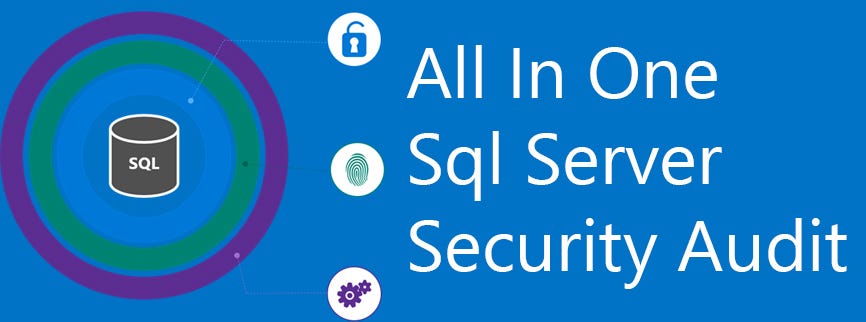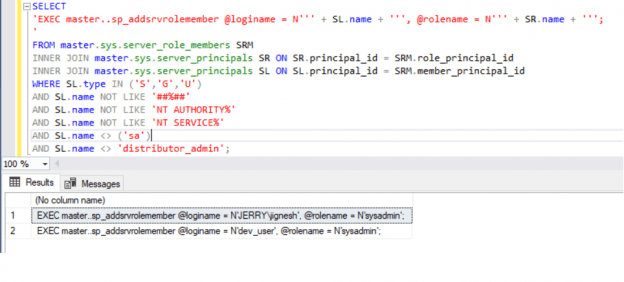Are you concerned about the security of your SQL server? Look no further! In this article, you will find a collection of essential SQL server security scripts that will help you safeguard your valuable data. With these powerful scripts, you can easily identify and fix security vulnerabilities, protect against unauthorized access, and enhance the overall security of your SQL server. So, get ready to fortify your database and ensure that it remains secure from any potential threats.

Introduction to SQL Server Security
SQL Server security is a critical aspect of database management. With increasing threats to data privacy and security, it is essential to understand the fundamentals of SQL Server security to protect sensitive information stored within your databases. This article will provide a comprehensive overview of SQL Server security, including authentication, authorization, auditing, and encryption.https://www.youtube.com/embed/XGxByiSSeJw
Understanding SQL Server Security
Authentication
Authentication is the process of verifying the identity of the user attempting to access a SQL Server instance or database. SQL Server provides multiple authentication modes, including Windows Authentication and SQL Server Authentication. Windows Authentication relies on the Windows operating system to authenticate users, while SQL Server Authentication uses a username and password stored within SQL Server.
Authorization
Authorization determines the level of access that a user has to a SQL Server instance or database. It involves granting specific permissions to users, allowing them to perform actions such as reading, writing, modifying, or deleting data. SQL Server authorization relies on the concept of roles, which are collections of permissions assigned to users to define their privileges.
Auditing
Auditing involves monitoring and recording database activity to ensure data security and comply with regulatory requirements. SQL Server provides built-in auditing features, such as SQL Server Audit, which enables the tracking of events and actions performed on the database. By auditing database activity, organizations can detect suspicious behavior, track changes, and investigate potential security breaches.
Encryption
Encryption plays a vital role in protecting sensitive data. SQL Server offers various encryption capabilities, such as Transparent Data Encryption (TDE), which automatically encrypts data at rest. TDE helps safeguard the data files, backups, and transaction log files from unauthorized access. Additionally, SQL Server supports encryption of data during transmission using Secure Sockets Layer/Transport Layer Security (SSL/TLS) encryption.

Common Security Vulnerabilities
While SQL Server provides robust security features, there are several common vulnerabilities that can put your data at risk if not addressed properly. It is essential to be aware of these vulnerabilities and take appropriate measures to mitigate them.
Weak Passwords
Weak passwords are a prevalent security vulnerability that can be easily exploited by attackers. Users often choose passwords that are easily guessable or use common dictionary words. Implementing strong password policies will prevent unauthorized access and significantly enhance security.
Unencrypted Connections
Unencrypted connections allow attackers to intercept and eavesdrop on data transmitted between client applications and the SQL Server. It is crucial to enforce encrypted connections using SSL/TLS encryption to protect sensitive data in transit.
Excessive User Permissions
Granting excessive user permissions can lead to data breaches or unauthorized modifications to the database. Regularly auditing user permissions and removing unnecessary privileges will help maintain a secure database environment.
Lack of Patch Updates
Failing to apply necessary patch updates can expose your SQL Server to known vulnerabilities. Regularly updating SQL Server with the latest patches and fixes ensures that security vulnerabilities are addressed promptly.

SQL Server Security Best Practices
Implementing security best practices is essential for maintaining a secure SQL Server environment. Consider the following best practices to enhance the security of your SQL Server instances and databases.
Regular Password Changes
Enforce a policy of regular password changes to minimize the risk of compromised credentials. By requiring users to change their passwords periodically, you reduce the likelihood of unauthorized access.
Enforcing Strong Passwords
Implement password complexity rules that require users to create strong passwords. A strong password should be of sufficient length, include a combination of letters, numbers, and special characters, and avoid dictionary words or personal information.
Implementing Encryption
Employ encryption techniques such as Transparent Data Encryption (TDE) to protect data at rest. TDE automatically encrypts the database files, backups, and log files, making it extremely difficult for unauthorized users to access sensitive information.
Limiting User Permissions
Regularly review and manage user permissions to ensure that they are appropriate for their assigned tasks. Restricting users to only the necessary permissions minimizes the potential for unauthorized actions or accidental data modifications.
Regular Patch Updates
Stay up to date with the latest SQL Server patches and updates. Keeping your SQL Server environment patched significantly reduces the risk of known security vulnerabilities being exploited.

Built-in Security Features in SQL Server
SQL Server offers several built-in security features that can further enhance the security of your databases:
Authentication Modes
SQL Server supports both Windows Authentication and SQL Server Authentication, allowing you to choose the most appropriate authentication mode based on your security requirements.
Database Roles
Database roles provide a way to manage permissions efficiently. You can assign permissions to roles rather than individual users, simplifying the management of user access.
Row-Level Security
Row-Level Security (RLS) enables you to control access to individual rows based on user-defined predicates. RLS allows for fine-grained access control, ensuring that users can only see and modify data they are authorized to access.
Transparent Data Encryption
Transparent Data Encryption (TDE) encrypts data at rest, making it unreadable without the proper decryption keys. TDE protects data files, backups, and transaction log files, providing an additional layer of security.
Dynamic Data Masking
Dynamic Data Masking (DDM) allows you to control sensitive data exposure by masking specific data elements. DDM ensures that sensitive data is not visible to unauthorized users, reducing the risk of data leakage.

Security Scripts for SQL Server
To assist in implementing SQL Server security best practices and addressing potential vulnerabilities, several security scripts can be utilized. These scripts can help validate password strength, configure encryption settings, audit user permissions, and verify patch compliance.
Script 1: Password Validation
This script can be used to validate the strength of user passwords. It checks for password length, special characters, and common passwords, ensuring that users create strong and secure passwords.
Script 2: Encryption Configuration
This script assists in configuring SSL/TLS encryption settings to enforce encrypted connections between client applications and the SQL Server. It also helps in enabling Transparent Data Encryption (TDE) to encrypt data at rest.
Script 3: User Permissions Audit
This script provides a comprehensive listing of users and their permissions within a SQL Server instance or database. It helps identify users with excessive permissions, allowing administrators to mitigate security risks by removing unnecessary privileges.
Script 4: Patch Compliance Check
This script checks the installed patches on SQL Server instances and identifies any pending updates. It helps ensure that your SQL Server environment remains up to date with the latest security patches, reducing the risk of known vulnerabilities.
In conclusion, SQL Server security is of utmost importance in protecting your data from unauthorized access and potential security breaches. By implementing best practices, leveraging built-in security features, and utilizing security scripts, you can establish a robust security framework for your SQL Server environment. Regularly reviewing and updating your security protocols will help safeguard your valuable data and maintain privacy and compliance.
Leave a Reply